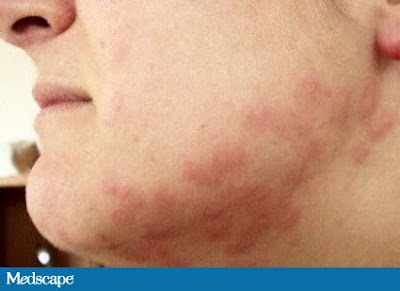.
How Can I Recognize and Treat Bed Bug Bites?
Theodore (Ted) D. Scott, RN, MSN, FNP-C, DCNP
Authors and Disclosures
Posted: 09/29/2010
With all this talk about an increase in bed bugs in cities across the United States, what do bed bug bites look like, how can they be treated, and what should I advise my patients about eradication/prevention?
Response from Theodore (Ted) D. Scott, RN, MSN, FNP-C, DCNP Clinical Preceptor, University of San Diego, San Diego, California; Nurse Practitioner, Kaiser-Permanente Medical Offices, San Marcus, California
Bed bugs (Cimex lectularius) are becoming more widespread in the United States, and bed bug infestations have been increasing since about 1995 (Figure 1). Bed bugs were apparently common until the 1940s, when synthetic pesticides like DDT were introduced. Review of the literature offers many postulated reasons for the re-emergence of the bed bug.[1-3]
Figure 1.

Adult bed bug feeding; actual size is 5 mm. CDC Public Health Image Library.
Photo by Piotr Naskrecki.
Bed bugs are elusive nocturnal feeders that hide in bedding, mattresses, and bedroom furniture. They pierce the skin of victims and take a blood meal. Like mosquitos and lice, their saliva contains proteins that anticoagulate blood and very often cause localized allergic reactions. The bites appear as recurrent erythemic pruritic papules on the face, neck, and extremities
(Figure 2).

Bed bug bites on a woman's face.
Wikipedia, public domain image.
Bed bugs will also bite under loose fitting clothing. The bites may also occasionally become bullous and resemble the lesions of erythema multiforme. Unlike lice and mosquitos, bed bugs do not transmit human disease. Hepatitis B, hepatitis C, and HIV have all been investigated for transmission by bed bugs, and no evidence for transmission has been found.
Bed bug bites are usually self-limiting and have durations of 3 to 10 days, but they can result in scarring. Oral or topical antihistamines or low potency topical corticosteroids will relieve the itching.
It is important to advise patients that they should not attempt to treat a bed bug infestation in their own homes by themselves. If they think they may have a bed bug infestation, they should contact a pest control specialist. This is not a pest that can be controlled with do-it-yourself measures. Most pesticides that are available to home users are not effective on bed bugs.
The following precautions can help to prevent a bed bug infestation at home:
Check secondhand furniture, beds, and couches for any sign of bed beg infestation before bringing them home;
Use a protective cover that encases your mattresses and box springs, which eliminates any hiding places; and
Reduce clutter in your bedroom to reduce hiding places for bugs.
When travelling:
In hotel rooms, use luggage racks to hold your luggage when packing and unpacking rather than setting your luggage on the floor or bed;
Check the mattress and headboard before sleeping; and
Upon returning home, unpack directly into the washing machine and inspect your luggage carefully.
References
No comments:
Post a Comment